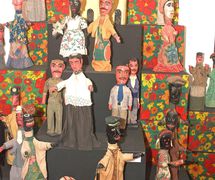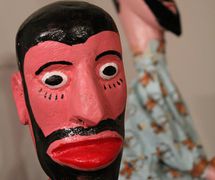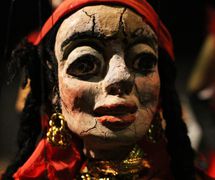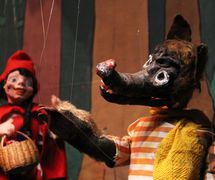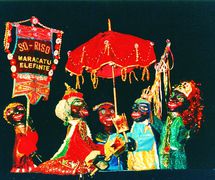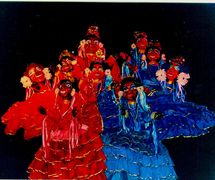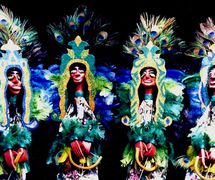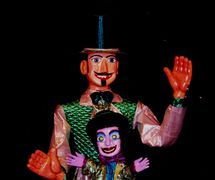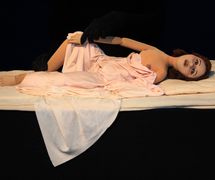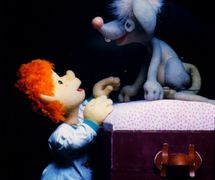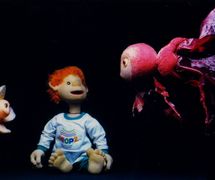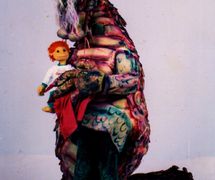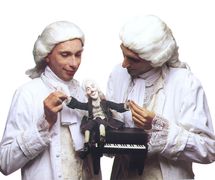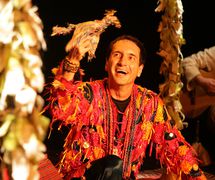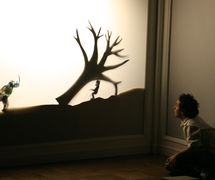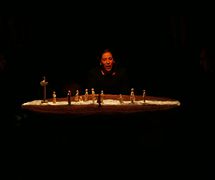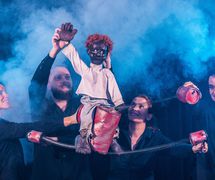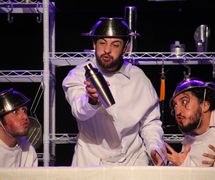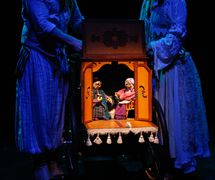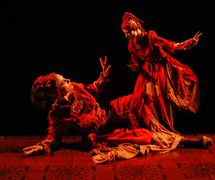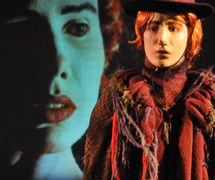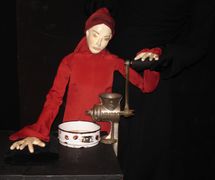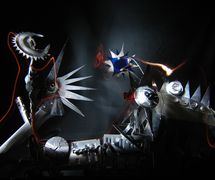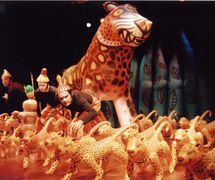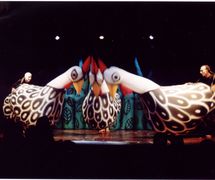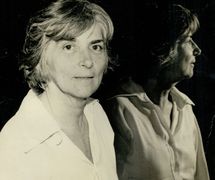Officially the Federative Republic of Brazil (Portuguese: República Federativa do Brasil), this South American nation is the largest, geographically, in the region of Latin America and the largest Portuguese-speaking country in the world. Situated on and below the equator, it is home to the Amazon River basin, and was inhabited by numerous tribal nations (including the Tupis, Guaranis, Gês, Arawaks, and their subgroups) before the Portuguese, in 1500, claimed the region for Portugal. Brazil declared its independence in 1822.
Sources and documents available about the origins of puppet theatre in Brazil are rare and scattered. However, it is certain that puppetry was brought by European colonizers in the 16th century.
The 18th and 19th Centuries
In O Rio de Janeiro no tempo dos vice-reis (Rio de Janeiro in the Time of the Viceroys, 1932), historian Luiz Edmundo describes the theatre of bonifrates (from the Latin bonus frater, good brother) as a very popular entertainment in the late 18th and early 19th centuries. It was a rather naive and improvisational theatre. In those years in Rio de Janeiro three types of performances could be seen: the títeres de porta (door puppets); títeres de capote (cloak puppets); and títeres de sala (room puppets). The first were improvised shows presented in the streets of the old town: in an open door, a brightly coloured cloth was placed above which the manipulator showed the puppets. A blind man playing a rebec accompanied him, and a plate with some coins was placed on the ground to draw generosity from those passing. The cloak puppets were shown at fairs, or anywhere frequented by people. The large cloak served as the stage under which a child manipulated the puppets, while the puppeteer spoke the text. The room puppets were presented inside, on a trestle or on boxes, in the rudimentary style of itinerant performers of the Middle Ages.
As in other parts of the world, this puppet theatre was initially religious. These “talking crèches” were known in Brazil as presepios de fala, and some evolved into more and more profane shows (see Nativity Scenes). The puppets were always glove puppets. Luiz Edmundo also mentions the presentation of an opera for string puppets, Ópera dos Vivos (Opera of the Living) in a specific theatre hall, inaugurated in Rio de Janeiro in the second half of the 18th century.
The 19th Century
During the 19th century, tours of European professional companies multiplied. Especially important were the tours of the Rome-based Teatro dei Piccoli of Vittorio Podrecca to São Paulo and the Automatic Company of the San Martiniano Theatre Royal from Turin to Rio de Janeiro. Under their influences in Rio in 1882, Teatro Jõao Minhoca (John Earthworm Theatre) was born. It was a variety theatre modelled after Italian puppetry in which the central character, Jõao Minhoca, was an astute and confrontational black boy who engaged in dialogue with character-types of Brazilian society of that time. He had his hour of glory in Rio de Janeiro, São Paulo and Minas Gerais for a while, but his success passed and his popularity declined, as without roots in folklore or tradition, this theatre was a momentary diversion. If these experiences created in the urban centres of South and Southeast Brazil fizzled, in the North and Northeast, on the other hand, a particular genre surged which still exists today: mamulengo.
The Professional Theatre in the 20th Century
Professional puppet theatre began to develop from the mid-20th century under the influence of a cultural and educational movement led by the Sociedade Pestalozzi (Pestalozzi Society). With it there was a surge of experimental schools with the goal to educate through artistic activities, which was at that time a new concept. Cultural exchanges between Brazilian and European artists that followed had repercussions on the arts in general and on the development of puppet theatre in particular. Helena Antipoff, founder of this society, aware of the role this art could play in education, created a number of puppet workshops and courses. Then the first amateur theatre troupes were born in Recife, Belo Horizonte, Porto Alegre, Rio de Janeiro and São Paulo, some of which became professional. Among them was the Teatro de Marionetes Monteiro Lobato (Puppet Theatre of Monteiro Lobato), founded in Recife in 1958 but soon moved to Rio de Janeiro, which remained active for over thirty years.
Olga Obry, a journalist and writer, directed the Teatro de Figuras (Theatre of Figures) in Rio de Janeiro. Virginia Valli worked with string puppets and fantoches (see Fantoccini), and was also equally innovative in the manipulation of rod puppets. The texts of Maria Clara Machado, author of children’s books and puppet plays, began to interest educators, while Augusto Rodrigues, also influenced by the Pestalozzi movement, founded Escolinha de Arte (Art School for Children) in Rio de Janeiro with courses in painting, dance, movement, sculpture and puppetry, unusual for the time.
Yolanda Fagundes brought a complete theatre set of puppets from Poland with which she created Teatro Gibi (Gibi Theatre), later directed by Beatriz Pinto de Almeida. In São Paulo, Antonieta Lex Leite founded the theatre troupe O Sacy, in which important artists of the theatre, literature and visual arts participated. Their productions were primarily for children but some were addressed to adults. With puppets designed by Darcy Penteado, the O Sacy troupe presented O pássaro de fogo, based on Stravinsky’s The Firebird; and Farsa Grotesca (Grotesque Farce) based on Aldous Huxley, as well as some of Martins Pena’s works, among others. This theatre was later incorporated into the Departamento de Cultura Municipal (Municipal Department of Culture), merging the playful and educational programmes of the Bibliotecas Públicas Infanto-Juvenis (public libraries for young children).
In the state of Rio Grande do Sul, there is the Teatro Infantil de Marionetes (TIM) (Children’s Puppet Theatre). Founded in 1954 in Porto Alegre, the theatre perpetuates itself, spanning three generations of the Sena family. Geraldo Casé, broadcaster by profession, also connected to amateur theatre, made inroads in the field of puppetry. His Teatro do Gesto (Theatre of Gesture) in the 1950s became a meeting place for talented artists, musicians and poets such as Tom Jobim, Vinicius de Moraes and Guilherme de Figueiredo. Teatro do Gesto was not a professional theatre but a place for artistic research which had an important influence on two Argentine puppeteers, Ilo Krugli and Pedro Dominguez (also known as Pedro Touron). They both arrived in Rio de Janeiro with a traditional guignol show, following in the line of the Di Mauro brothers and Mané Bernardo, who initiated them to this art in Buenos Aires (Argentina). For Pedro Touron, the discovery of Geraldo Casé’s theatre in 1960 was decisive. As for Ilo Krugli, he subsequently created the Teatro Ventoforte (Strong Wind Theatre) in São Paulo in 1974, still active today.
The 1970s
From the 1970s, the puppet troupes began to organize themselves in order to develop a more critical approach to pedagogical and artistic contents and to better concern themselves with production and dramaturgy. New initiatives appeared by such companies as: Grupo A Carreta (The Cart) of Manoel and Marilda Kobachuk and Jorge Crespo (1970); Grupo Revisão (Review/Revision) of Maria Luzia Lacerda; or the company Contadores de Histórias (Storytellers) of Marcos and Rachel Ribas. The group Laborarte in the state of Maranhão, directed by Tácito Borralho and Nelson Brito, sought to recover popular expression and to encourage a pedagogical-artistic movement, while research on popular theatre was launched by Mamulengo Só-Riso in Olinda.
In São Paulo, O Casulo (The Cocoon), founded and directed by Ana Maria Amaral in 1976, surprised critics and audiences by a show for adults, Palomares, with her poetry and her subject of nuclear pollution, the result of an accident in a Spanish village. In Santa Catarina, the group Gralha Azul (Azure Jay/Blue Jay) also tackled environmental themes, denouncing in its shows the dangers of deforestation.
Among all the Brazilian troupes that emerged in this era, Giramundo from Minas Gerais stands out. The group was founded in 1970 by Álvaro Apocalypse, a master of theatrical and visual-plastic expression in both technique and form. His production, Cobra Norato (1979, based on a poem by Brazilian poet Raul Bopp), is now a classic, while Giramundo continues its activities and maintains a school and museum.
From the 1980s to the Early Years of the 21st Century
The puppet theatre in Brazil, broadened and enriched since 1980 through interaction with other forms of visual arts, such as dance, and use of new techniques of lighting and sound, had emerged from its isolation. In expressing all they have in common with the contemporary orientations of actors’ theatre, Brazilian puppeteers opened new paths. The figuration of puppets was no longer exclusively anthropomorphic, but leaned toward abstract and symbolic representation. The characters-objects faced live actors; the separation between actors’ theatre and the theatre of puppets decreased. By mixing techniques, styles and forms from various cultures, contemporary Brazilian performances have moved away from the traditional puppet theatre and have moved closer to a “theatre of animation”. In the globalized world of international exchanges and links (festivals, tours, travel, workshops, Internet), it is thus becoming more difficult to detect regional differences.
This new creativity is spreading across the country. In the early 1980s, Cem Modos (One Hundred Ways), an innovative group directed by Luiz Ferré, immersed itself into experiments in television, actors’ theatre, street theatre, as well as advertising. Osvaldo Gabrielli won international attention for both visual/plastic arts and performance. At the same time that large productions like those of XPTO (founded in 1985 by Osvaldo Gabrielli) expanded the stage space, mixing live actors, animated objects and puppets, other important companies, such as Teatro Lambe Lambe in Salvador, Bahia (colloq. Salvador da Bahia), directed by Denise Santos, and Caixa de Imagens (Box of Images) in São Paulo, created by Monica Simões, presented poetic scenes within tiny boxes, as in a micro theatre. The troupe Pia Fraus, founded in São Paulo in 1992 by Beto Lima and Beto Andreetta, is among those companies that seek to integrate multiple languages in their creations (masks, actors and puppets, giant figures … ).
As for Grupo Sobrevento, directed by Luiz André Cherubini, this company has, since 1986, presented in Rio de Janeiro and São Paulo a repertoire that is both very modern and founded on tradition. In some of its productions, Sobrevento blurs the boundaries between the theatre of puppets and the theatre of actors, for example, mixing into the staging unusual found objects, puppets, masked actors and accompanied by live heavy metal music (Ubu, 1996). While in other productions the company respects tradition, performing with traditional glove puppets, which are manipulated with great precision (Momentos de Mozart Mozart Moments, 1991).
Caixa do Elefante (Elephant Box Company), created by Mario Ballenti and Paulo Balardim in Porto Alegre in 1991, and Cia. Zero (Companhia Zero), founded by Vilma Rodrigues in Belo Horizonte, go with well-chosen innovations and techniques and tradition, as does the troupe Cia. Truks (Companhia Truks) of Verônica Gerchman, Henrique Sitchin and Cláudio Saltini, with the award-winning author and illustrator Eva Furnari, in their productions for children. There are other troupes, for example, the Cia. Teatro Lumbra (Companhia Teatro Lumbra de Animação) created by Alexandre Fávero in Porto Alegre in 2001, which push the norm by presenting montages where it is difficult to tell whether what they do, or what is witnessed, is theatre, video, or theatre with or of puppets. Through television, the puppet reaches an audience of millions but loses the intimacy it had with its audience. But this impoverishment can sometimes be offset by remarkable creations such as the twin brothers, Tiarajú and Ubiratan of the group Anima Sonho (Anima Dream), artists who manage to conserve intimacy through virtuosity and humour.
Differences between popular and erudite puppetry or traditional versus contemporary theatre, are taken over by “artists who coexist with these realities and recreate the follies and the words of people”, as well noted by Valmor Beltrame in speaking of the companies Mamulengo Só-Riso of Fernando Augusto G. dos Santos and Mamulengo Presepada of Chico Simões.
The first academic research on puppetry has also developed since the 1980s. However, with only sporadic courses on offer, professional training is insufficient.
In terms of dramaturgy or playwriting, in general, the puppet theatre follows the same trends as that marking actors’ theatre: deconstruction. Almost always what is seen are fragments or juxtaposed scenes: as in Giramundo’s play, Giz (Chalk); in O Casulo’s Babel Formas e Transformaçoes (Babel, Forms and Transformations, 1991) and Dicotomias (Dichotomies, 2003); in the Teatro Sim …Porque não? drama, Livres e Iguais (Free and Equal, 1999); or in Marcos and Raquel Ribas’ Contadores de Histórias production, Maturando (Maturing).
But the diversity of the Brazilian stage is such that it is impossible to generalize or reduce to only one aspect. Whether it be with the actor, the puppet, object or image, contemporary creation today seeks an expression integrating a wide variety of languages.
(See also Ana María Amaral, Bumba Meu Boi, Centro de Communicaçáo Social do Nordeste (CECOSNE), Felisberto Sabino da Costa, Hermilo Borba Filho, Magda Augusta Castanheira Modesto, Museu do Mamulengo.)
Bibliography
- Acioli, Conceição. Quando Pirilampos Desafiam Faróis: um estudo sobre a atualidade das tradições brasileiras do teatro de bonecos [When Fireflies Defy Lighthouses: A Study of Current Brazilian Puppetry Traditions]. Dissertação de Mestrado [Master’s Dissertation]. Universidade de São Paulo-USP, 2001.
- Alcure, Adriana Schneider. A Zona da Mata é rica de cana e brincadeira: uma etnografia do Mamulengo [The Zona da Mata is Rich in Sugarcane and Jokes/Fun and Games: An Ethnography of Mamulengo]. Tese de Doutorado [Doctoral Thesis]. Universidade Federal do Rio de Janeiro-UFRJ, 2007.
- Alcure, Adriana Schneider. Mamulengos dos mestres Zé Lopes e Zé de Vina: etnografia e estudo de personagens [Mamulengos Masters Zé Lopes and Zé de Vina: Ethnography and Study of Characters]. Dissertação (Mestrado). Universidade Federal do Estado do Rio de Janeiro-UNIRIO, 2001.
- Apocalypse, Alvaro. Dramaturgia para a nova forma da marionette [Dramaturgy for a New Form of Puppet]. Belo Horizonte: Escola das Artes da Marionete/EAM-Giramundo, 2000.
- Amaral, Ana Maria. O Teatro de Bonecos no Brasil e em São Paulo de 1940 a 1980 [The Puppet Theatre in Brazil and São Paulo in the 1940s to the 1980s]. São Paulo: COM-ARTE, 1994.
- Amaral, Ana Maria. Trans. Maria Claudia Rodgrigues Alves. Le Théâtre de marionnettes au Brésil et à São Paulo des années quarante aux années quatre-vingt [The Puppet Theatre in Brazil and São Paulo in the 1940s to the 1980s]. São Paulo: COM-ARTE, 1994.
- Amaral, Ana Maria. Teatro de Bonecos em São Paulo [Puppet Theatre in São Paulo]. 1983. Dissertação (Mestrado). Universidade de São Paulo-USP, 1983.
- Amaral, Ana Maria. Teatro de Formas Animadas [Theatre of Animated Forms]. Tese (Doutorado). Universidade de São Paulo-USP, 1989.
- Beltrame, Valmor. Teatro de Bonecos no Boi-de-Mamão: Festa e Drama dos Homens no Litoral de Santa Catarina [Puppet Theatre in the Boi-de-Mamão: Fiesta and Drama of the Men in Santa Catarina Litoral]. Dissertação (Mestrado em Artes Cênicas). Universidade de São Paulo, 1995.
- Bezerra Gomes, Jose. Teatro de João Redondo [Theatre of João Redondo]. Natal: Funadação José Augusto, 1975.
- Borba Filho, Hermilo. Apresentação do Bumba-meu-boi [Presentation of the Bumba-meu-boi]. Recife: Guararapes, 1982.
- Borba Filho, Hermilo. Fisionomia e espirito do mamulengo [Appearance and Spirit of Mamulengo]. Rio de Janeiro: INACEN, 1987.
- Borralho, Tácito Freire. O Boneco, do imaginário popular maranhense ao Teatro: uma análise de “O Cavaleiro do Destino” [The Puppet, From Maranhão Popular Imagination To the Theatre: An Analysis of “The Knight of Destiny”]. São Luís: Secretaria de Estado da Cultura, 2005.
- Borralho, Tácito Freire. O Teatro do Boi do Maranhão: brincadeira, ritual, enredos, gestos e movimentos [The Theatre of the Boi (Ox) of Maranhão: Play, Ritual, Plotlines, Gestures and Movements]. Tese (Doutorado em Artes). ECA/USP, São Paulo, 2012.
- Braga, Humberto. Pappagalli lurrera animatutako espedizioa: brasilidar txofxongilo antzerkia. Expedición animada a tierra pappagalli: el teatro de títeres bresilleño [Animated Expedition in the Land of Parrots: Brazilian Puppet Theatre]. Tolosa: Centro de Initiativas de Tolosa, 2000. Exhibition catalogue.
- Brochado, Izabela Costa. “Distrito Federal: o mamulengo que mora nas cidades 1990-2001” [Federal District: Mamulengo Living in Cities 1990-2001]. Dissertação de Mestrado em História. Programa de Pós-Graduação em História. Instituto de Ciências Humanas. Universidade de Brasília, 2001.
- Brochado, Izabela Costa. “Mamulengo Puppet Theatre in the Socio-Cultural Context of Twentieth-Century Brazil”. PhD Thesis. Samuel Beckett School of Drama, Trinity College Dublin 2005.
- Cherubini, Luis Andre Miguel Vellinho, Sandra Vargas, et. al. Teatro Sobrevento. São Paulo: Edição Grupo Sobrevento, Apoio Secretaria Municipal de Cultura, [n.d.].
- Coelho, Angela M. Escudeiro. Bonequeiro de Escada, perfil de Augusto Bonequeiro [Puppeteer of Escada, Profile of Augusto Bonequeiro]. Fortaleza: Editora IMEPH, 2007.
- Cossu, Giorgio, photographer with Celina Dávilla, interviewer. Mamulengo: Teatro popolare di burratini in Brassile [Mamulengo: Popular Puppet Theatre in Brazil]. Pisa: Totivilus Edizione, 2008. (In Italian, includes a DVD)
- Gurgel, Deífilo. João Redondo – um teatro de bonecos do Nordeste [João Rotondo – Puppet Theatre of the Northeast]. Petrópolis: Vozes/UFRN, 1986.
- Júlio, Larissa Miranda. Dramaturgia em movimento: tendências poéticas no teatro de animação dos grupos Giramundo e Catibrum [Dramaturgy in Motion: Poetic Trends in Animation Theatre of the Groups Giramundo and Catibrum]. Dissertação (Mestrado em Artes). Universidade Federal de Uberlândia, 2011.
- Lima, Marcondes. A arte do brincante no mamulengo e no bumba-meu-boi [The Art of the Brincante (Players) in Mamulengo and Bumba-meu-boi]. Dissertação (Mestrado em Teatro). Universidade Federal da Bahia, 2003.
- Mikol, Bruno, Magda Modesto and Fernando Augusto Santos. Marionnettes en territoire brésilien [Puppets in Brazilian Territory]. Charleville-Mézières: Institut International de la Marionnette, 1994.
- Modesto, Magda. “A Arte do Titere no Brasil: Novas Tendências de Pesquisa” [The Art of Puppetry in Brazil: New Tendencies in the Search]. Adagio. Nos. 30/31, 2001, pp. 52-57.
- Obry, Olga. “The Haps and Mishaps of Brazilian Puppets”. World Theatre. Vol. XIV, No. 5, 1965, pp. 454-457.
- Pimentel, Altimar de Alencar. O Mundo Mágico de Joáo Redondo [The Magical World of João Redondo]. Rio de Janeiro: Ministério da Cultura: Fundação National de Artes Cénicas, 1988.
- Santos, Fernando Augusto Gonçalves. Mamulengo: um povo em forma de bonecos [Mamulengo: A People in the Form of Puppets]. Rio de Janeiro: FUNARTE, 1979.
- Silva, H. Pereira da. “Teatro de Bonecos” [Puppet Theatre]. Revista de Teatro. No. 462, 1987, pp. 11-12.
- Simões, Francisco de Oliveira Neto. A Tradição do Mamulengo. Relatório de Pesquisa apresentado ao Minc do Brasil [A Tradition of Mamulengo. Research Report presented to (Ministério da Cultura) MinC do Brasil]. Bolsa Virtuose. Brasília, 2001.
- Simões, Chico, and Alipio Carvalho Neto. “Mamulengo”. Puck. No. 12. Charleville-Mézières: Éditions de l’Institut international de la marionnette, 1999.
- Simões, Chico, and Alipio Carvalho Neto. “Mamulengo: O Teatro de Bonecos no
- Nordeste Brasileiro” [Mamulengo: The Puppet Theatre in Northeast Brazil]. Adagio. No. 20, 1999, pp. 1-5.
- Souza, J. Galante de. O Teatro no Brasil [Theatre in Brazil]. Vol. 1. Rio de Janeiro: Ministério da Educação e Cultura/INL, 1960.
- Vieria, Sergio. Vida de Boneco [Puppet Life]. Curitiba: Imagemsul, 2006.










